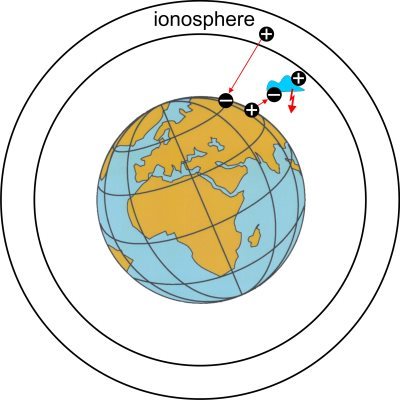Natural static fields
Electromagnetic fields have always been present on the earth. Natural electromagnetic fields occur mainly as thermal radiation (infrared), visible light or ultraviolet radiation from the sun. Fire and lightning are also sources of electromagnetic fields. Additionally, we have the geomagnetic field and the electric field between the ground and upper layers of the atmosphere, which is explained below.
The earth's magnetic field, also known as the geomagnetic field (GMF), is a quasi-static magnetic field that encloses our earth from the South Pole to the North Pole (Figure). It is caused mainly by electric currents in the liquid part of the Earth's core. At the Poles the magnetic field is twice as strong as at the equator. The geomagnetic field depends on the geological depth and latitude; on the Earth surface it ranges from 30-70 µT. Thus, the geomagnetic field is the strongest magnetic field we are continuously exposed to. In relation to the ground, the field lines pass horizontally at the equator und perpendicularly at the Poles. In Central Europe the field lines enter diagonally into the ground. The angle between the horizontal surface of the ground and the field lines is called inclination.
The magnitude of the geomagnetic field and the inclination angle can be determined for any location in Germany with the aid of an online-tool at the
GFZ German Research Centre for Geosciences Potsdam.

Natural electric fields are also present on the earth. Electric fields occur mainly between the ground and upper layers of the atmosphere (the ionosphere, from 70 km altitude). They are mainly caused by the radiation of the sun and by solar winds. The magnitude of the static electric field depends on the activity of the sun, the conductivity of the air, the season and the weather. For example, during the winter the field strength is 270 V/m, which is twice as high as in the summer (130 V/m). In contrast, during thunderstorms over a flat terrain field strengths can reach levels of 20,000 V/m with peaks of up to 300,000 V/m (during lightning). The huge electric field strengths are caused by heated, humid air masses in the thunderclouds. Sudden discharges by lightning result in electromagnetic impulses (sferics), measurable even in long distances (see also Natural intermediate frequency fields).
